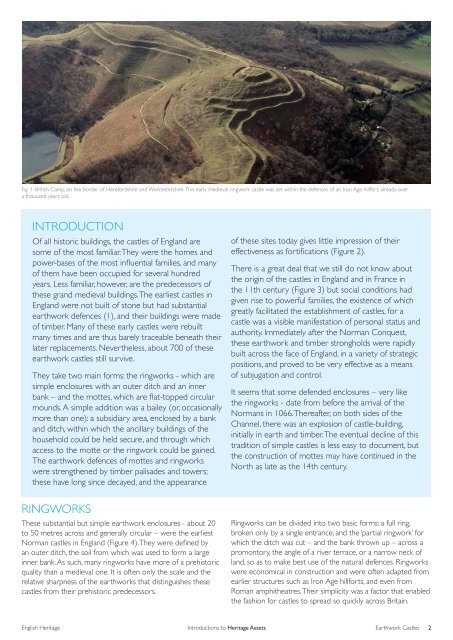Introductions to Heritage Assets - Earthwork Castles - English Heritage
Introductions to Heritage Assets - Earthwork Castles - English Heritage
Introductions to Heritage Assets - Earthwork Castles - English Heritage
Create successful ePaper yourself
Turn your PDF publications into a flip-book with our unique Google optimized e-Paper software.
Fig. 1. British Camp, on the border of Herefordshire and Worcestershire. This early medieval ringwork castle was set within the defences of an Iron Age hillfort, already over<br />
a thousand years old.<br />
INTRODUCTION<br />
Of all his<strong>to</strong>ric buildings, the castles of England are<br />
some of the most familiar. They were the homes and<br />
power-bases of the most influential families, and many<br />
of them have been occupied for several hundred<br />
years. Less familiar, however, are the predecessors of<br />
these grand medieval buildings. The earliest castles in<br />
England were not built of s<strong>to</strong>ne but had substantial<br />
earthwork defences (1), and their buildings were made<br />
of timber. Many of these early castles were rebuilt<br />
many times and are thus barely traceable beneath their<br />
later replacements. Nevertheless, about 700 of these<br />
earthwork castles still survive.<br />
They take two main forms: the ringworks - which are<br />
simple enclosures with an outer ditch and an inner<br />
bank – and the mottes, which are flat-<strong>to</strong>pped circular<br />
mounds. A simple addition was a bailey (or, occasionally<br />
more than one): a subsidiary area, enclosed by a bank<br />
and ditch, within which the ancillary buildings of the<br />
household could be held secure, and through which<br />
access <strong>to</strong> the motte or the ringwork could be gained.<br />
The earthwork defences of mottes and ringworks<br />
were strengthened by timber palisades and <strong>to</strong>wers;<br />
these have long since decayed, and the appearance<br />
RINGWORKS<br />
These substantial but simple earthwork enclosures - about 20<br />
<strong>to</strong> 50 metres across and generally circular – were the earliest<br />
Norman castles in England (Figure 4). They were defined by<br />
an outer ditch, the soil from which was used <strong>to</strong> form a large<br />
inner bank. As such, many ringworks have more of a prehis<strong>to</strong>ric<br />
quality than a medieval one. It is often only the scale and the<br />
relative sharpness of the earthworks that distinguishes these<br />
castles from their prehis<strong>to</strong>ric predecessors.<br />
of these sites <strong>to</strong>day gives little impression of their<br />
effectiveness as fortifications (Figure 2).<br />
There is a great deal that we still do not know about<br />
the origin of the castles in England and in France in<br />
the 11th century (Figure 3) but social conditions had<br />
given rise <strong>to</strong> powerful families, the existence of which<br />
greatly facilitated the establishment of castles, for a<br />
castle was a visible manifestation of personal status and<br />
authority. Immediately after the Norman Conquest,<br />
these earthwork and timber strongholds were rapidly<br />
built across the face of England, in a variety of strategic<br />
positions, and proved <strong>to</strong> be very effective as a means<br />
of subjugation and control.<br />
It seems that some defended enclosures – very like<br />
the ringworks - date from before the arrival of the<br />
Normans in 1066. Thereafter, on both sides of the<br />
Channel, there was an explosion of castle-building,<br />
initially in earth and timber. The eventual decline of this<br />
tradition of simple castles is less easy <strong>to</strong> document, but<br />
the construction of mottes may have continued in the<br />
North as late as the 14th century.<br />
Ringworks can be divided in<strong>to</strong> two basic forms: a full ring,<br />
broken only by a single entrance; and the ‘partial ringwork’ for<br />
which the ditch was cut – and the bank thrown up – across a<br />
promon<strong>to</strong>ry, the angle of a river terrace, or a narrow neck of<br />
land, so as <strong>to</strong> make best use of the natural defences. Ringworks<br />
were economical in construction and were often adapted from<br />
earlier structures such as Iron Age hillforts, and even from<br />
Roman amphitheatres. Their simplicity was a fac<strong>to</strong>r that enabled<br />
the fashion for castles <strong>to</strong> spread so quickly across Britain.<br />
<strong>English</strong> <strong>Heritage</strong><br />
<strong>Introductions</strong> <strong>to</strong> <strong>Heritage</strong> <strong>Assets</strong><br />
<strong>Earthwork</strong> <strong>Castles</strong><br />
2

















